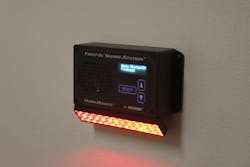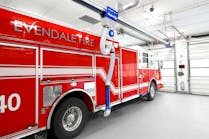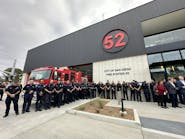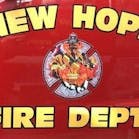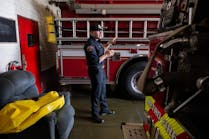In 2009, the Oklahoma City Fire Department advertised a request for proposal (RFP) for a new fire station alerting system. We were constructing a few new fire stations and wanted to use a new style of alerting system.
When we began the RFP process, the alerting system at each individual station was activated through radio signals sent from radio consoles in the fire dispatch office. This meant there was not any type of electronic interface with our CAD system. The only interface was the dispatcher dispatching the companies in CAD, then turning to the radio console and activating the lights and audio at the stations housing the companies that had just been dispatched. Of course there was a natural delay between the CAD dispatch time stamp and the activation of the alerting system at the fire stations. In essence, the firefighters did not "know" they had been dispatched until their lights and audio were subsequently activated.
Our new fire station design also called for individual sleeping rooms for each firefighter. Using the regular alerting system would prohibit being able to individually alert those on the unit being dispatched while not disturbing those who did not need to respond. The individual sleeping rooms were one of the other factors prompting us to explore the idea of a new alerting system.
Many people with multiple areas of expertise were involved in the process of writing the RFP, selecting a proposal, and then working with a selected vendor through purchasing and installing the new alerting system. This process involved fire department, IT, radio, purchasing and construction personnel to make it work.
The Oklahoma City Fire Department worked with the selected vendor, Westnet, through designing our new system for the new stations, developing a solution for our existing stations, and configuring and installing the new system.
The process of obtaining our new alerting system was sometimes challenging and we learned many lessons along the way. I wrote this article to outline several items to think about if you are considering purchasing and installing a new fire station alerting system, or even upgrading your existing system.
Find a guru
Everyone needs to find a person that is technically savvy, understands the political landscape, is able to successfully navigate the purchasing policy waters, and has a passion for the overall project. In other words, find a guru! I can hear many of you saying, "That type of person doesn’t exist, do they?"
I would usually agree with you, but we were very lucky indeed to find our guru in Oklahoma City: Lucien Jones. He recently retired after 43 years of service to the city and served as a police officer, IT expert, telephone service professional, constructed city buildings, and served as a 9-1-1 systems expert. Jones is also a certified ICS Communications Unit Leader (COML). He was passionate about our station alerting process, wrote the RFP, served on the selection committee, and was instrumental in the successful installation. His previous projects allowed him experience in working with city purchasing policies. So, before you begin the process of purchasing and installing a fire station alerting system, find your guru.
Keep your IT personnel involved
You will want to keep fire department or the municipal IT personnel involved at every step of the journey. They are valuable while configuring the alerting system and while setting up any interfaces that are involved, for example the CAD-to-alerting system interface. Most importantly, the IT personnel need to be involved because they will most likely be maintaining the alerting system after installation.
In our particular situation, we relied on many of the IT teams within our city. We are fortunate to have an excellent staff of uniform and civilian personnel who work directly for the fire department as IT professionals. They provide first-tier and some second-tier support for the system. Also, our system crosses many lines in the IT world and we rely on city IT personnel to provide support as well. Our system uses servers, the network, radio system, CAD system, etc., so it takes a village to make sure all the pieces of the system are working well. We are truly thankful for our “IT Village” in Oklahoma City.
Keep your radio system personnel involved
I want to specifically mention keeping your radio system personnel involved. In our city, the Radio Shop is part of the IT Department. They have a very special function and are vital to the alerting system.
In our department's system, a piece of the Westnet system triggers the radio system at each station and through the radio system, the dispatch orders are verbalized. In addition, we still have the "old method" of using the radio consoles to activate the lights and audio at each station. In fact, this serves as our back-up method to alerting fire stations if part of the regular alerting system is down, such as the network. So, our Radio Shop personnel work closely with us to help maintain the overall functioning of the alerting system.
Get your purchasing personnel involved
You will want to get purchasing personnel involved early in the game, too. They are a vital link to ensuring that all city, state, and federal purchasing policies, guidelines and laws are followed correctly. They will also know the best methods of funding the system and can help you navigate the details of actually purchasing the equipment, contracting with the vendors, and negotiating any maintenance contracts that may be necessary.
Outfitting older fire stations?
We did not have the budget to outfit our older stations with all the periphery items for our new system. We only wanted the specialized devices at the new stations. Also, we did not want dispatchers having to manage two separate methods of alerting all of our stations.
Our goal was to have an interface with the CAD system and, if possible, eliminate the extra step of using the radio consoles to alert the stations. Our vendor was able to come up with a solution to interface with all current fire stations with a smaller version of their Master Control Unit. This device allows the system to activate the lights and audio for these stations. This means that when any of our units are dispatched in CAD, the station lights and audio are automatically activated and dispatchers can begin verbalizing the dispatch orders without having to manually trigger the "older" stations with the radio consoles. This saves time and provides a more rapid overall response.
Ensure the system has back-up features
Our system is IP-based. We have a very robust city network and also use private carriers for portions of our network, so the potential is there to experience some outages, as we all occasionally do on IP networks. As I mentioned before, we have the ability to use the radio system as a back-up alerting system. Also, we can use landline or cell phones as a tertiary method of alerting. So, don’t be afraid to go IP, but be sure you have a back-up plan.
How many bells and whistles do I need?
Fire station alerting vendors offer many "bells and whistles" with their systems. You will want to decide which features you want and those that you can live without. We chose to use many of the features at our new stations.
Earlier, I talked about individual sleeping rooms and the ability to alert only those firefighters who need to respond with the specific company. The dorm remote device was a "must have" for our new stations. However, we chose not to install these at existing stations, mainly because those stations still have one large dorm room. We also chose to use the lights with the new system at the new stations. These are strips of LED lights that are white and then turn red when the station is alerted. Some of the new stations actually use these lights as their regular lighting rather than the traditional florescent lights that are installed.
Finally, one of features we use at the new stations is the turnout timer. This is a clock mounted at the front of the apparatus bay at a height visible from inside the cab of the rigs. This clock starts when the station is alerted, allowing the crews to gauge their turnout time for every incident. The bottom line; you may or may not need all the “bells and whistles” of an alerting system, it’s OK to pick the pieces that are best for your needs.
Stay grounded
Another important point is to determine that your grounding is correct. We have experienced several lightning strikes at our fire stations. We are finding that in many of the cases of lightning strikes where we have lost significant amounts of equipment, the ground wire has been grounded to a false ground like a metal truss that sits on wood beams. A true ground needs to lead to an eight-foot spike that leads into the soil that remains moist to aid in dissipating the electrical charge. This would be the absolute minimum for existing structures and new construction would need grounding that encircles the entire building. So, be sure you “stay grounded” during your installation.
In closing
Purchasing and installing a new fire station alerting system was a very rewarding process. I truly believe our department and ultimately our citizens are better served by utilizing the alerting system we chose. I would encourage anyone out there who is looking at a new alerting system to consider our thoughts and ideas and feel free to use our lessons learned to ensure you obtain the best product and system for your situation.
This article was written with assistance from Major Jim Kruta, Oklahoma City Fire IT Major.
BRIAN STANALAND is a battalion chief with the Oklahoma City Fire Department where he has worked for 26 years. He oversees Support Services, which includes dispatch, human resources, and fire IT. Stanaland served in various roles for the department including firefighter/EMT, dispatcher, human resources officer, public information officer and emergency management fire liaison. Stanaland is a University of Oklahoma graduate and has served as a volunteer in various capacities for the YWCA over the past 20 years.
